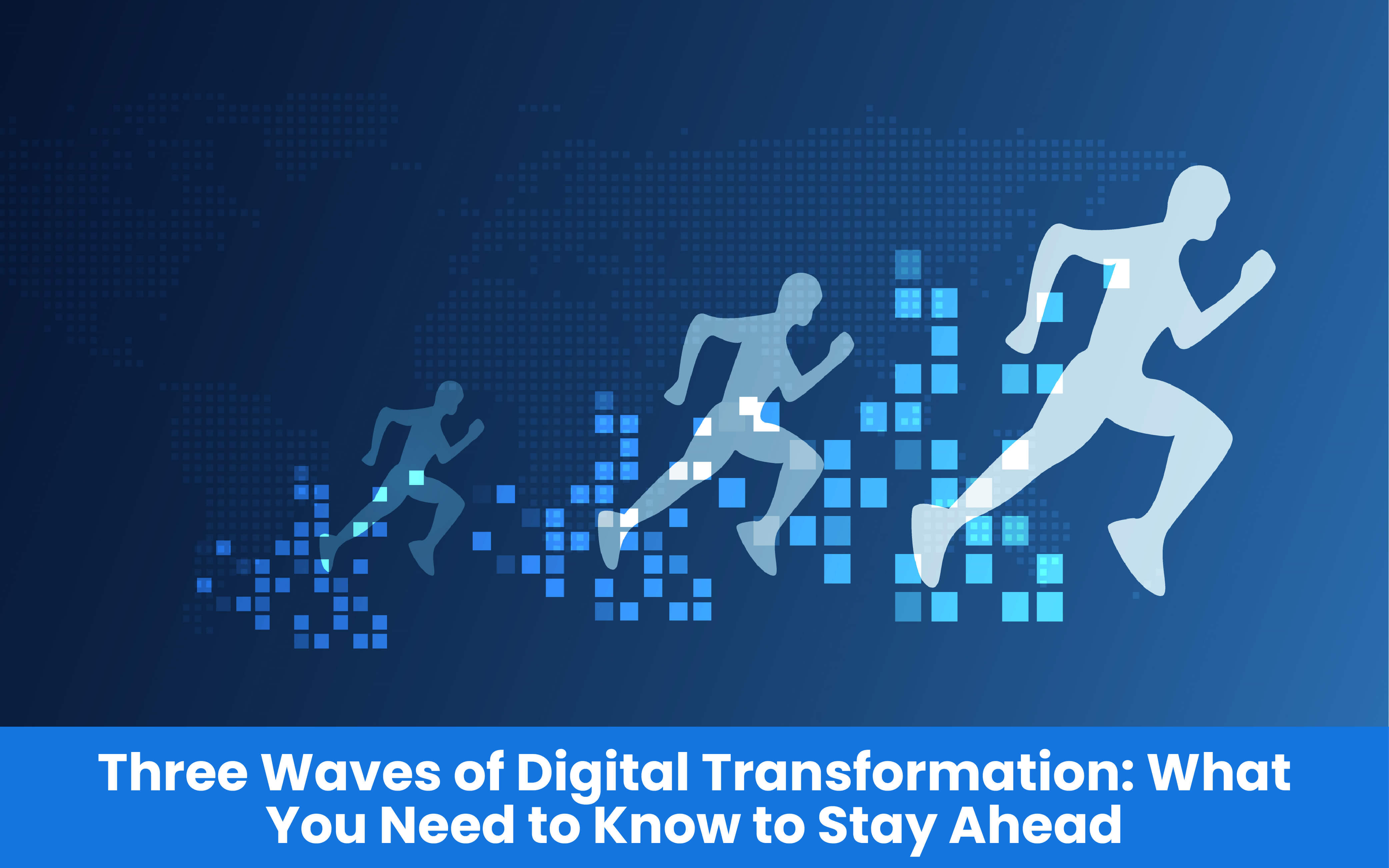Blogs
To know about all things Digitisation and Innovation read our blogs here.
Digital Transformation
Three Waves of Digital Transformation: What You Need to Know to Stay Ahead
SID Global Solutions
22 February 2023

Digital transformation has become a buzzword in the business world, and for good reason. The digitization of processes, products, and services has enabled organizations to become more efficient, innovative, and customer-focused. However, the concept of digital transformation is not new. It has been evolving over the years, and businesses need to understand the three waves of digital transformation to stay ahead.
In this article, we will explore the three waves of digital transformation, what they mean, and how businesses can prepare for them.
Wave 1: Automation and Optimization
The first wave of digital transformation started in the 1990s when businesses began using computers to automate and optimize their operations. The focus was on improving efficiency and reducing costs by replacing manual processes with digital ones. Businesses implemented enterprise resource planning (ERP) systems, customer relationship management (CRM) software, and supply chain management (SCM) solutions to streamline their operations.
The first wave of digital transformation was also characterized by the rise of the internet and e-commerce. Businesses began to build their online presence and started selling their products and services online. The internet provided a new channel for businesses to reach customers, and e-commerce enabled them to sell to customers around the world.
However, the first wave of digital transformation was primarily focused on automation and optimization. It did not fundamentally change how businesses operate or how they create value for customers.
Also Read: How Digital Transformation is Shaping the Future of Customer Experience?
Wave 2: Digitization and Innovation
The second wave of digital transformation started in the early 2000s and was driven by the digitization of products and services. The focus shifted from optimizing existing processes to creating new digital products and services that provided more value to customers.
The rise of smartphones, social media, and cloud computing enabled businesses to create new digital experiences for customers. The second wave of digital transformation was characterized by the emergence of platforms and ecosystems that brought together customers, partners, and suppliers to create new value.
Businesses started using data analytics and artificial intelligence (AI) to gain insights into customer behavior and preferences. They began using these insights to personalize their products and services and create more engaging customer experiences.
The second wave of digital transformation was also characterized by the rise of agile development methodologies and the adoption of DevOps practices. These practices enabled businesses to develop and deploy new products and services quickly and iterate based on customer feedback.
Wave 3: Disruption and Transformation
The third wave of digital transformation is happening right now, and it is characterized by disruption and transformation. The focus has shifted from optimizing existing processes and creating new digital products and services to fundamentally transforming how businesses operate and how they create value for customers.
The third wave of digital transformation is being driven by emerging technologies such as blockchain, 5G, and the internet of things (IoT). These technologies are enabling businesses to create new business models and revenue streams by leveraging data and connectivity.
The third wave of digital transformation is also characterized by the rise of platforms and ecosystems that enable businesses to collaborate and co-create value with partners and customers. These platforms and ecosystems are blurring the lines between industries and creating new opportunities for businesses to enter new markets.
However, the third wave of digital transformation also presents significant challenges for businesses. The pace of change is faster than ever before, and businesses need to be agile and adaptive to survive. They need to be able to experiment, iterate, and pivot quickly based on customer feedback and changing market conditions.
Also Read: Why a Digital Mindset is Critical for Customer-Centric Digital Transformation
Preparing for the Three Waves of Digital Transformation
To prepare for the three waves of digital transformation, businesses need to adopt a people-first approach. They need to focus on understanding the needs and preferences of their customers and create products and services that provide value.
Businesses also need to invest in digital talent and skills development. They need to attract and retain employees who have the skills and knowledge to work with emerging technologies such as AI, blockchain, and the IoT. They also need to create a culture of innovation and experimentation that encourages employees to explore new ideas and take risks.
To prepare for the first wave of digital transformation, businesses need to focus on process automation and optimization. They need to identify manual processes that can be automated and implement software solutions that streamline their operations. This will enable them to reduce costs, improve efficiency, and free up resources that can be invested in innovation.
To prepare for the second wave of digital transformation, businesses need to focus on digitization and innovation. They need to leverage emerging technologies such as AI and data analytics to gain insights into customer behavior and preferences. They also need to adopt agile development methodologies and DevOps practices to develop and deploy new digital products and services quickly.
To prepare for the third wave of digital transformation, businesses need to focus on disruption and transformation. They need to embrace emerging technologies such as blockchain and the IoT and leverage them to create new business models and revenue streams. They also need to collaborate with partners and customers to create platforms and ecosystems that enable them to co-create value.
Conclusion
Digital transformation is an ongoing process, and businesses need to understand the three waves of digital transformation to stay ahead. The first wave of digital transformation was focused on process automation and optimization. The second wave of digital transformation was focused on digitization and innovation. The third wave of digital transformation is focused on disruption and transformation.
Also Read: 6 Essential Tools for a Successful Digital Transformation
SID Global Solutions is a leading provider of digital transformation services that help clients overcome the challenges of digital disruption. With a deep understanding of the three waves of digital transformation, SID Global Solutions pioneers innovative solutions that enable clients to create value and stay ahead of the competition. Whether it’s process automation and optimization, digitization and innovation, or disruption and transformation, SID Global Solutions has the expertise, talent, and resources to deliver results. By adopting a people-first approach, investing in digital talent and skills development, and creating a culture of innovation and experimentation, SID Global Solutions helps clients navigate the complex landscape of digital transformation and unlock new growth opportunities. Whether it’s developing custom software solutions, implementing new technologies, or driving digital innovation, SID Global Solutions is committed to helping clients succeed in the digital age.









